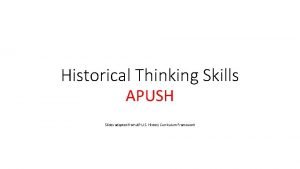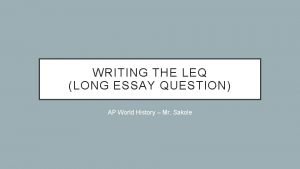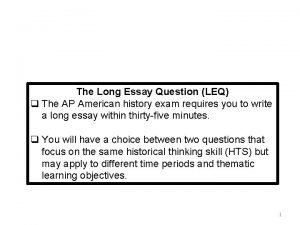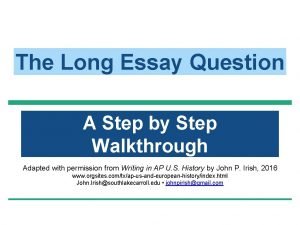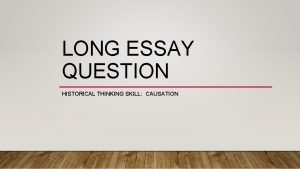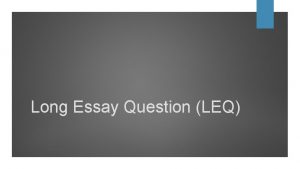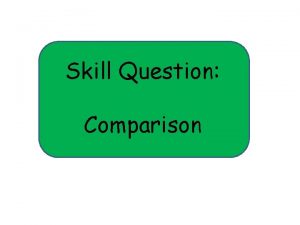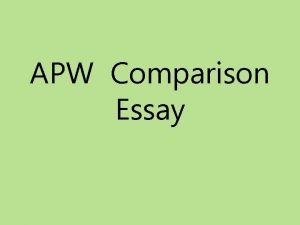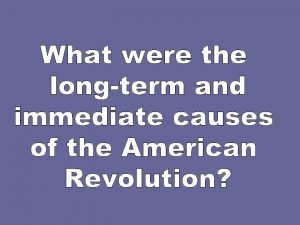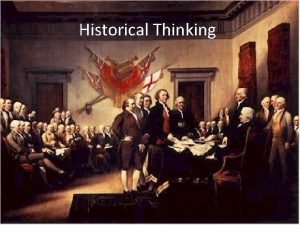LONG ESSAY QUESTION HISTORICAL THINKING SKILL COMPARISON SECTION








- Slides: 8

LONG ESSAY QUESTION HISTORICAL THINKING SKILL: COMPARISON

SECTION II, PART B: THE LONG ESSAY QUESTION (LEQ) 1 QUESTION, 35 MINUTES, 15% OF EXAM SCORE • Assesses the student on ONE of FOUR historical thinking skills • Causation • Comparison • Continuity/Change Over Time • Periodization • You will: • Select one question from two choices (both will assess THE SAME historical thinking skill). • Explain and analyze significant issues in world history • Develop an argument supported by analysis of historical evidence

PART OF THE RUBRIC: THESIS (1 POINT) • You will: • Present a thesis that makes a historically defensible claim • Respond to all parts of the question • Write thesis in one or more sentences located in one place, either in the introduction or the conclusion • Write a thesis that is clear, concise, and SPECIFIC!

PARTS OF THE RUBRIC: ARGUMENT DEVELOPMENT - USING THE TARGETED HISTORICAL THINKING SKILL (2 POINTS) • HTS: Comparison • Depending on the wording of the prompt, you will DESCRIBE in the body paragraphs of your essay either (1 point): • ONE VALID SIMILARITY AND ONE VALID DIFFERENCE (“Analyze a similarity and a difference…”) OR • TWO VALID SIMILARITIES AND TWO VALID DIFFERENCES (“Analyze similarities and differences…”) OR • ONE VALID SIMILARITY OR ONE VALID DIFFERENCE (“Analyze a similarity or a difference…”) OR • TWO VALID SIMILARITIES OR TWO VALID DIFFERENCES (“Analyze similarities or difference…”)

PARTS OF THE RUBRIC: ARGUMENT DEVELOPMENT - USING THE TARGETED HISTORICAL THINKING SKILL (2 POINTS) • HTS: Comparison • You will EXPLAIN the reasons for the similarity(ies) AND/OR difference(s) you identify and describe (1 point) • You will answer the question: “WHY ARE THESE TWO HISTORICAL ‘THINGS’ SIMILAR (OR DIFFERENT)? ” • This means you will provide the REASON for their similarity or difference. • We do not know at the time of the essay HOW MANY times you will have to analyze the reasons for the similarity(ies) or difference(s), so you should try to do this analysis your identified and described areas of comparison. FOR ALL of

PARTS OF THE RUBRIC: ARGUMENT DEVELOPMENT – USING EVIDENCE (2 POINTS) • You will ADDRESS the topic of the question with SPECIFIC examples of relevant evidence (1 point) • This means that you provide SPECIFIC FACTUAL INFORMATION (SFI) related to your thesis and/or the question prompt • We do not know, at the time of the essay, HOW MANY pieces of SFI you must provide so include as much as you can remember that is relevant to your thesis and/or the question prompt. • We also do not know HOW MANY pieces of SFI you need for each similarity or difference but you can assume that you MUST have at least ONE PIECE of SFI for each similarity and/or difference you identify in your essay • RULE OF 3!!

PARTS OF THE RUBRIC: ARGUMENT DEVELOPMENT – USING EVIDENCE (2 POINTS) • You will UTILZE specific example of evidence to fully and effectively substantiate the stated thesis or a relevant argument (1 point) • This is the “show the evidence supports your thesis” point. • It is not enough to list a bunch of pieces of SFI together to earn this point. You have to demonstrate that you know how to support an argument using SFI. • This means you have to EXPLAIN your use of the evidence to support your argument. • This also means you have to have a wide range of evidence to support your argument • This means that you can’t have a long “laundry list” of, for example, trade items and nothing else to support your argument. You must vary the type of evidence you provide.

PARTS OF THE RUBRIC: SYNTHESIS (1 POINT) • You will EXTEND the argument by EXPLAINING the CONNECTIONS between your argument (i. e. your thesis, part of your thesis, a similarity, or a difference) and ONE of the following: • A development in a different historical period, situation, era, or geographical area. • A course theme and/or approach to history that is not the focus of the essay (such as political, economic, social, cultural, or intellectual history • A different discipline or field of inquiry (such as economics, government and politics, art history, or anthropology) • The key to this point is MAKING the CONNECTIONS between your argument and your chose area of synthesis. • It is not enough to just use a phrase or reference. • If you wait until the end of the essay, you must repeat the part of your argument you are extending as well as the connection you are making to these other areas.




